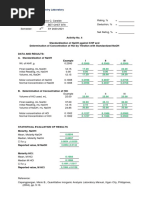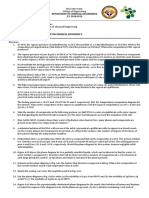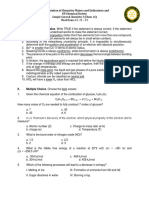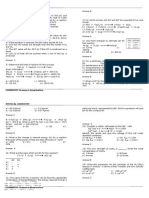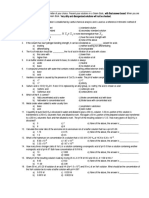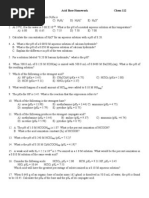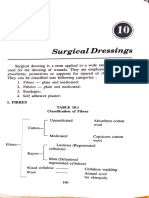Exam 2 Answers
Exam 2 Answers
Uploaded by
Junior HighCopyright:
Available Formats
Exam 2 Answers
Exam 2 Answers
Uploaded by
Junior HighOriginal Title
Copyright
Available Formats
Share this document
Did you find this document useful?
Is this content inappropriate?
Copyright:
Available Formats
Exam 2 Answers
Exam 2 Answers
Uploaded by
Junior HighCopyright:
Available Formats
Exam 2 (Ch.16, Ch.
17) Answers
1. Calculate the pH of a 0.075 M solution of HClO 4.
pH = 1.125
(Texbook p.679)
2. What is the concentration of KOH in a solution that has pH = 10.69?
[KOH] = 4.90 x 10-4 M
(Texbook p.679)
3. The Ka of a weak acid is 5.5 x 10-4. What is the pH of a 0.63 M solution of this
acid?
HA
pH = 1.73
H 2O
A-
H3O+
Dissociation of weak acid
(Texbook p.685)
4. A 0.12 M solution of weak base has a pH of 10.76. Determine K b.
B
Kb = 2.77 x 10-6
H2O
BH+
OH-
Dissociation of weak base
(Texbook p.682)
5. Calculate the pH of a 0.050 M solution of carbonic acid. ( K a(1) = 4.2 x 10-7, Ka(2)
= 4.8 x 10-11)
H2CO3
HCO3-
+
+
pH = 3.83
H2O
H2O
HCO3
CO3
(Texbook p.689)
2-
+
+
H3O+
H3O+
Dissociation of weak acid
6. Calculate the pH of a 0.082 M solution of NaCN. (K a HCN = 4.9 x 10-10 )
NaCN
CN- +
Na+
H 2O
+ CN-
H CN
Dissociation of salt
+
OH -
Hydrolysis of salt
pH = 11.11 (Texbook p.696)
7. Consider 1 L of a buffer that is 1.5 M HCN and 1.2 M NaCN. Calculate the pH
after the addition of 0.25 mol NaOH. (Ka HCN = 4.9 x 10-10)
HCN/CNHCN +
pH = 9.37
Buffer
H 2O
CN-
H3O+
Buffer
(Texbook p.727)
8. Calculate the pH at the equivalence point in the titration of 30 mL of 0.25 M
CH3COOH with 0.25 M KOH. (Ka CH3COOH = 1.8 x 10-5 Kb CH3COO- = 4.9 x 10-10)
CH3COOH + KOH CH3COO K+ + H2O
CH3COOH
+ H2O CH3COO +
CH3COO + H2O
pH = 8.89
H3O+
CH3COOH + OH-
(Texbook p.735)
titration
Buffer
Hydrolysis of salt
9. Calculate the pH after the addition of 25 mL of 0.10 M NaOH to 50 mL of 0.10
M HF.(pKa HF = 3.15)
HF + NaOH F Na+ + H2O
HF
+ H 2O F +
F + H2O
pH = 3.15
H3O+
HF + OH-
Titration
Buffer
Hydrolysis of salt
(Texbook p.735)
10.Which of the following best describes the titration of a acetic acid with
sodium hydroxide
a. low starting pH, and pH = 7 at equivalence point
b. high starting pH, and pH = 7 at equivalence point
c. high starting pH, and pH < 7 at equivalence point
d. low starting pH, and pH > 7 at equivalence point
(Texbook p.734)
11. What range of pH values could be achieved with a buffer consisting
of nitrous acid,HNO2 (Ka = 4.5 x 10-4) and sodium nitrite, NO2- .
2.35 4.35
(Texbook p.726)
12. The pH of two different solutions was determined before and after the
addition of small amounts of strong acid (0.001 mol).
Solution A
Solution B
pH = 3.2 (before)
pH = 3.2 (before)
pH = 3.8 (after)
pH = 0.7 (after)
From these measurements we can conclude that:
a) Solution A is a buffer
b) Solution B is a buffer
(Texbook p.723)
13. What happens to the pH of the solution of weak acid, HA, from problem 3
after the addition of 0.63 M solution of its salt NaA.
a) it decreases (more acidic)
b) it stays the same
c) it increases
(less acidic) (Texbook p.727)
14. Which statement is correct for this reaction
HSO4-
+ NH3
SO42-+
+ NH4+
a) HSO4- acts as a base
b) SO42- is the conjugate acid of HSO4c) NH3 acts as a base
d) NH3 is the conjugate acid of NH4+
(Texbook p.669)
15. What is a conjugate acid-base pair in the reaction?
CN- +
a)
b)
c)
d)
H 2O
CN- and
H2O
CN- and HCN
HCN and OHCN- and OH-
H CN
OH -
(Texbook p.670)
16. A buffer is prepared by dissolving equimolar amounts of HCO 3- and CO32in water
HCO3- + H2O CO32- + H3O+
Buffer
The addition of HCl to this buffer results in:
a) a decrease in the HCO3b) an increase in the CO32c) a decrease in the CO32(Texbook p.727)
d) no change in the concentration of CO 32- or HCO3-
17. What is the pH of a solution made by combining 150 mL of 0.125 M HCl
and 150 mL of 0.130 M KOH.
pH = 11.4
(Texbook p.731)
Exam 2 (Ch.16, Ch.17) Answers
1. Calculate the pH of a 0.03 M solution of KOH.
pH = 12.48 (Texbook p.679)
2. What is the concentration of HClO4 in a solution that has pH = 1.12 ?
[H+] = 0.076 M (Texbook p.679)
3. The Kb of a weak base is 1.7 x 10-9. What is the pH of a 0.63 M solution of this
base?
B
pH = 9.51
H2O
BH+
OH-
Dissociation of weak base
(Texbook p.691)
4. A 0.12 M solution of weak acid has a pH of 3.5. Determine K a.
HA
H 2O
Ka = 8.34 x 10-7
A-
H3O+
Dissociation of weak acid
(Texbook p.682)
5. Which statement is correct for this reaction
HSO4a) HSO4-
+ NH3
acts as a base
SO42-+
+ NH4+
b) SO42- is the conjugate acid of SO42c) NH3 acts as a base
(Texbook p.669)
d) NH3 is the conjugate acid of NH4+
6. What is a conjugate acid-base pair in the reaction?
CN- +
H 2O
a) CN- and
b) CN- and
c) HCN and
H CN
H2O
HCN
OH-
d) CN- and
OH -
(Texbook p.670)
OH
7. Calculate the pH of a 0.30 M solution of hydrosulfuric acid, H 2S. ( Ka(1) = 9.5 x 10-8,
Ka(2) = 1 x 10-19)
H 2S
acid
HS-
H2O
H2O
HS
S
2-
+
+
H3O+
Dissociation of weak
H3O+
pH = 3.77 (Texbook p.689)
8. Calculate the pH of a 0.82 M solution of NaNO 2. (Ka HNO2 = 4.5 x 10-4 )
NaNO2
Na+
+ NO2NO2 +
H2O
HNO2 +
pH = 8.63
OH-
Dissociation of salt
Hydrolysis of salt
(Texbook p.696)
9. What range of pH values could be achieved with a buffer consisting of
formic acid,HCOOH (Ka = 1.7 x 10-4) and sodium formate, HCOO- .
2.77 4.77
(Texbook p.726)
10. Consider 1 L of a buffer that is 1.2 M HCN and 1.5 M NaCN. Calculate the
pH after the addition of 0.25 mol HCl. (Ka HCN = 4.9 x 10-10)
HCN/CNHCN +
Buffer
H 2O
CN-
H3O+
Buffer
pH = 9.23 (Texbook p.727)
11. The pH of two different solutions was determined before and after
the addition of small amounts of strong acid (0.001 mol).
Solution A
Solution B
pH = 9.2 (before)
pH = 9.2 (before)
pH = 3.8 (after)
pH = 9.0 (after)
From these measurements we can conclude that:
a) Solution A is a buffer
b) Solution B is a buffer
(Texbook p.727)
12. What happens to the pH of the solution of weak base, B, from problem 3
after the addition of 0.63 M solution of its salt.
a) it decreases (less basic)
(Texbook p.727)
b) it stays the same
c) it increases
(more basic)
13. A buffer is prepared by dissolving equimolar amounts of HCO 3- and CO32in water
HCO3- + H2O CO32- + H3O+
Buffer
The addition of HCl to this buffer results in:
a) a decrease in the HCO3-
b) an increase in the CO32c) a decrease in the CO32(Texbook p.727)
d) no change in the concentration of CO 32- or HCO3-
14. Calculate the pH at the equivalence point in the titration of 10 mL of 0.25
M CH3COOH with 0.25 M KOH.( Ka CH3COOH = 1.8 x 10-5 Kb CH3COO- = 4.9 x 10-10)
CH3COOH + KOH CH3COO K+ + H2O
CH3COOH + H2O CH3COO + H3O+
CH3COO + H2O
CH3COOH + OH-
titration
Buffer
Hydrolysis of salt
pH = 8.89 (Texbook p.735)
15. Calculate the pH after the addition of 35 mL of 0.10 M NaOH to 30 mL of
0.10 M HCN.(Ka HCN = 4.9 x 10-10)
HCN + NaOH CN Na+ + H2O
Titration
HCN +
H 2O
CN + H2O
CN- +
HCN + OH-
H3O+
Buffer
Hydrolysis of salt
pH = 11.92 (Texbook p.735)
16. Which of the following best describes the titration of ammonia with nitric
acid
a. low starting pH, and pH = 7 at equivalence point
b. high starting pH, and pH = 7 at equivalence point
c. high starting pH, and pH < 7 at equivalence point (Texbook p.737)
d. low starting pH, and pH > 7 at equivalence point
17. What is the pH of a solution made by combining 150 mL of 0.125 M HNO 3
and 150 mL of 0.130 M NaOH.
pH = 11.40 (Texbook p.731)
You might also like
- Collins - Integrated Science For The Caribbean 3 PDF67% (15)Collins - Integrated Science For The Caribbean 3 PDF233 pages
- Sample First Long Exam (Chem 17) : CHEM 17 (2 Sem, AY 15 - 16) UP ACME - Page 1 of 5No ratings yetSample First Long Exam (Chem 17) : CHEM 17 (2 Sem, AY 15 - 16) UP ACME - Page 1 of 55 pages
- Want Chemistry Games, Drills, Tests and More? You Need To Become An !No ratings yetWant Chemistry Games, Drills, Tests and More? You Need To Become An !18 pages
- Organic Compounds and The Atomic Properties of CarbonNo ratings yetOrganic Compounds and The Atomic Properties of Carbon110 pages
- Question: The Following Primary Standards Can Be Used For The StandardiNo ratings yetQuestion: The Following Primary Standards Can Be Used For The Standardi5 pages
- 5.00 EV Are Required To Remove An Electron From Th...No ratings yet5.00 EV Are Required To Remove An Electron From Th...2 pages
- Alkanes, Alkenes, Alkynes, and CycloalkanesNo ratings yetAlkanes, Alkenes, Alkynes, and Cycloalkanes162 pages
- CHEM 178 Stauffer Chelsea Practice Multiple Choice Exam 1 - KeyNo ratings yetCHEM 178 Stauffer Chelsea Practice Multiple Choice Exam 1 - Key5 pages
- Exam No. 2 Midterm Exam: Test II: Balancing The Chemical Equations Direction0% (1)Exam No. 2 Midterm Exam: Test II: Balancing The Chemical Equations Direction2 pages
- Topic 5 Volumetry 1col EdJVS - 2019 - 19prob For LecNo ratings yetTopic 5 Volumetry 1col EdJVS - 2019 - 19prob For Lec15 pages
- Chapter 6: Reactions of Alkenes - Addition Reactions: Trans-1,2-Dimethylcyclopentane Cis-1,2-DimethylcyclopentaneNo ratings yetChapter 6: Reactions of Alkenes - Addition Reactions: Trans-1,2-Dimethylcyclopentane Cis-1,2-Dimethylcyclopentane21 pages
- Exam #1 Study Guide: Overall Format of Exam: Exam #1 Will Consist of 25-30 MultipleNo ratings yetExam #1 Study Guide: Overall Format of Exam: Exam #1 Will Consist of 25-30 Multiple1 page
- Eko Fransiska - Pelayanan Dispensing Sediaan Steril Berdasarkan Standar UspNo ratings yetEko Fransiska - Pelayanan Dispensing Sediaan Steril Berdasarkan Standar Usp49 pages
- Development and Characterization of Chitosan Film: January 2011No ratings yetDevelopment and Characterization of Chitosan Film: January 20119 pages
- CATÁLOGO DE PRODUCTO - Valvulas de alivio de presion directa Crosby OMNI_TRIMNo ratings yetCATÁLOGO DE PRODUCTO - Valvulas de alivio de presion directa Crosby OMNI_TRIM40 pages
- Composites Part C: Open Access: Chiara Zarna, Mihaela Tanase Opedal, Andreas T. Echtermeyer, Gary Chinga-CarrascoNo ratings yetComposites Part C: Open Access: Chiara Zarna, Mihaela Tanase Opedal, Andreas T. Echtermeyer, Gary Chinga-Carrasco17 pages
- Summative Test 3: Section A Time: 30 MinutesNo ratings yetSummative Test 3: Section A Time: 30 Minutes8 pages
- HP Carbamate Pumps Damage Failure ReportNo ratings yetHP Carbamate Pumps Damage Failure Report10 pages
- Waterproofing, Construction Chemicals Manufacturers & Suppliers IndiaNo ratings yetWaterproofing, Construction Chemicals Manufacturers & Suppliers India8 pages
- Dopak: Process Sampler Type S32-LG Process To Flare With Outage Tube Configuration (F7)No ratings yetDopak: Process Sampler Type S32-LG Process To Flare With Outage Tube Configuration (F7)2 pages
- MSDS Potassium Phosphate Monobasic AnhydrousNo ratings yetMSDS Potassium Phosphate Monobasic Anhydrous7 pages
- Collins - Integrated Science For The Caribbean 3 PDFCollins - Integrated Science For The Caribbean 3 PDF
- Sample First Long Exam (Chem 17) : CHEM 17 (2 Sem, AY 15 - 16) UP ACME - Page 1 of 5Sample First Long Exam (Chem 17) : CHEM 17 (2 Sem, AY 15 - 16) UP ACME - Page 1 of 5
- Want Chemistry Games, Drills, Tests and More? You Need To Become An !Want Chemistry Games, Drills, Tests and More? You Need To Become An !
- Organic Compounds and The Atomic Properties of CarbonOrganic Compounds and The Atomic Properties of Carbon
- Question: The Following Primary Standards Can Be Used For The StandardiQuestion: The Following Primary Standards Can Be Used For The Standardi
- 5.00 EV Are Required To Remove An Electron From Th...5.00 EV Are Required To Remove An Electron From Th...
- CHEM 178 Stauffer Chelsea Practice Multiple Choice Exam 1 - KeyCHEM 178 Stauffer Chelsea Practice Multiple Choice Exam 1 - Key
- Exam No. 2 Midterm Exam: Test II: Balancing The Chemical Equations DirectionExam No. 2 Midterm Exam: Test II: Balancing The Chemical Equations Direction
- Topic 5 Volumetry 1col EdJVS - 2019 - 19prob For LecTopic 5 Volumetry 1col EdJVS - 2019 - 19prob For Lec
- Chapter 6: Reactions of Alkenes - Addition Reactions: Trans-1,2-Dimethylcyclopentane Cis-1,2-DimethylcyclopentaneChapter 6: Reactions of Alkenes - Addition Reactions: Trans-1,2-Dimethylcyclopentane Cis-1,2-Dimethylcyclopentane
- Exam #1 Study Guide: Overall Format of Exam: Exam #1 Will Consist of 25-30 MultipleExam #1 Study Guide: Overall Format of Exam: Exam #1 Will Consist of 25-30 Multiple
- Eko Fransiska - Pelayanan Dispensing Sediaan Steril Berdasarkan Standar UspEko Fransiska - Pelayanan Dispensing Sediaan Steril Berdasarkan Standar Usp
- Development and Characterization of Chitosan Film: January 2011Development and Characterization of Chitosan Film: January 2011
- CATÁLOGO DE PRODUCTO - Valvulas de alivio de presion directa Crosby OMNI_TRIMCATÁLOGO DE PRODUCTO - Valvulas de alivio de presion directa Crosby OMNI_TRIM
- Composites Part C: Open Access: Chiara Zarna, Mihaela Tanase Opedal, Andreas T. Echtermeyer, Gary Chinga-CarrascoComposites Part C: Open Access: Chiara Zarna, Mihaela Tanase Opedal, Andreas T. Echtermeyer, Gary Chinga-Carrasco
- Waterproofing, Construction Chemicals Manufacturers & Suppliers IndiaWaterproofing, Construction Chemicals Manufacturers & Suppliers India
- Dopak: Process Sampler Type S32-LG Process To Flare With Outage Tube Configuration (F7)Dopak: Process Sampler Type S32-LG Process To Flare With Outage Tube Configuration (F7)



